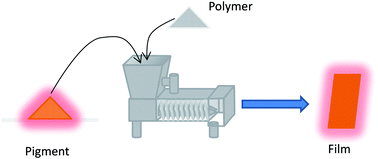Extruded polymer films pigmented with a heterogeneous ion-pair based lumophore for O2 sensing
Abstract
A novel approach to polymeric Ru(II)–diimine luminescent O2 sensors is described. The Ru(II)–diimine, tris(4,7-diphenyl-1,10-phenanthroline)ruthenium(II) dichloride ([Ru(dpp)3]2+), is first ion-paired to the surface of heterogeneous TiO2 particles, rendered negatively charged due to the alkali nature of the aqueous solution, to produce an O2 sensitive pigment with a strikingly high oxygen sensitivity (i.e. PO2 (S = 1/2) = 0.002 atm, where PO2 (S = 1/2) is defined as the amount of oxygen required to reduce the initial, oxygen free luminescence by 50%), and a rapid response to oxygen. The pigment is extruded in low density polyethylene (LDPE) to produce a thin (60 μm), flexible, O2 sensing plastic film, with an O2 sensitivity (PO2 (S = 1/2) = 0.84 atm) comparable to the more traditional homogeneous lumophore ion-pair based O2 sensor ink films reported in the literature.


 Please wait while we load your content...
Please wait while we load your content...